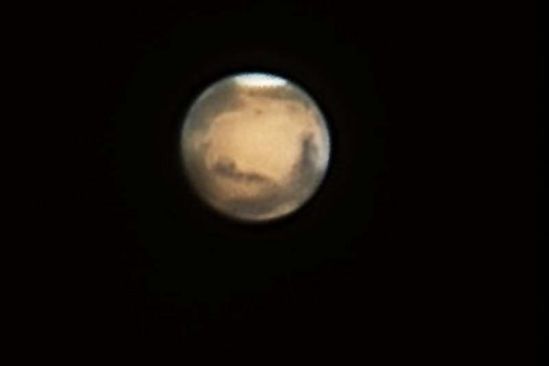Fred Barrett | May 02, 2018
Venus, Jupiter and Mars are real treats to observe this Month! Saturn is coming on strong as well. Jupiter reaches opposition on May 8th. That means that Earth will be in a direct line between Jupiter and the Sun and Jupiter will be at its closest to our planet – can’t get any better than that. The King of planets won’t be alone up there. Venus is bright just north of the Hyades star cluster which can be found to the upper right of Orion in the western horizon. Saturn rises soon after midnight in early May and is followed by Mars an hour or so later. At twilight Jupiter can be seen low in the east around 8:30 pm. You should wait for the planet to climb higher to get the best views. All 4 planets can be viewed in binoculars, especially Jupiter with its 4 largest moons dancing about it from night to night. Telescopes are much more modestly priced than they used to be. A 4 inch reflector from a reputable dealer would be a couple of hundred dollars and would greatly enhance observing the planets and deep sky objects (DSO’s) as well. Saturn with its glorious rings can be found near Sagittarius just above the asterism known as the Teapot. Although you won’t notice much change in the appearance of Venus, Jupiter and Saturn through the month, Mars shows a dramatic change. Mars will be in opposition in late July and will be closer to the Earth than it has been since 2003. The Red Planet will brighten and grow larger as May progresses, nearly doubling in size and brightness as it heads towards opposition. Mars will move eastward as May continues and can best be viewed just before twilight when it is highest in the sky. An interesting fact about this Mars opposition is that it’s a perihelic opposition. When at perihelion, Mars is closest to the Sun in its orbit and therefore closer to the Earth. Another interest fact I stumbled across in my research is that Mars’ 2 moons Phobos and Deimos may not be captured asteroids. Work by astronomers suggest that the moons resulted from a violent impact similar to the collision that formed our own Moon but on a smaller scale. By the way, the names of the 2 moons translate as ‘Panic’ and ‘Terror’ and are named after the 2 horses of the mythological war god ‘Mars’.
The Eta Aquariid peaks just before dawn on May 6. Halley’s Comet provides the debris that produces this meteor shower. Meteors will increase leading up to the peak and gradually diminish in following nights. Sadly the light from a gibbous Moon will interfere with viewing. Try to block out the Moon with a tree or building to cut down on the light. Ten meteors per hour are expected. The radiant , the origin point of the meteors, is in Aquarius.
To review, Venus is in the west and Jupiter in the southeast in early evening. Wait until midnight and you will find Jupiter has moved to the south and Saturn rises in the southeast. In early morning you will find Mercury in the east, Mars has moved to the south, Jupiter to the southwest and Saturn is in the south.
Here’s what to watch for in May. All times are in EDT.
May 4: The Moon passes just north of Saturn at 4 pm. You will need a scope for this one.
May 5: The Moon is at apogee (farthest from Earth) - 402,100 Kms.
May 6: The Eta Aquariid meteor shower peaks.
May 7: Last quarter Moon.
May 8: Jupiter is at opposition at 9 pm. Don’t miss it!
May 15: New Moon.
May17: The Moon is 5 degrees south of Venus at 2 pm. Give it a try in binoculars. You may be able to make out bright Venus.
The Moon is at perigee (closest to Earth) – 361,600 Kms.
May 21: First Quarter Moon.
May 27: The Moon passes 4 degrees above Jupiter.
May 29: Full Moon. This Moon is named the Full Flower Moon. I finally have daffodils but the Tulips are few and far between. I guess a snow storm will do that! It is also known as the Full Corn Moon. Not much corn planting going on this far north yet.
May 31: The Moon passes 1.6 degrees above Saturn.
Keep looking up!
“The Beginner’s Observing Guide by Leo Enright can be ordered from the Royal Astronomical Society of Canada at www.rasc.ca/publications. A subscription to our very own excellent Canadian astronomy magazine “SkyNews” can be arranged at the RASC website as well.
Let me know how your observing has gone this month, especially anything unusual. I enjoy the feedback. If you have any questions or suggestions you can contact me through this paper or email me at This email address is being protected from spambots. You need JavaScript enabled to view it. .Clear Skies! Fred.
More Stories
- No Winner Yet in Catch The Ace But Fundraising Target Met
- South Frontenac Food Bank Opens Second Location in Battersea
- Sharbot Lake Pentecostal Church Anniversary - 1925-2025
- Frontenac Holistic Health Fair - September 20 At Storrington Centre
- Odd Year For Real Estate - But Sales Are Steady Year Over Year
- 193rd Kingston Fall Fair
- Kim Phuc - the Napalm Girl - To Visit Flinton In November
- South Frontenac Council - September 2
- Sticker Shock - EV Charging Station To Cost North Frontenac Township
- 30th Anniversary Verona Car Show

